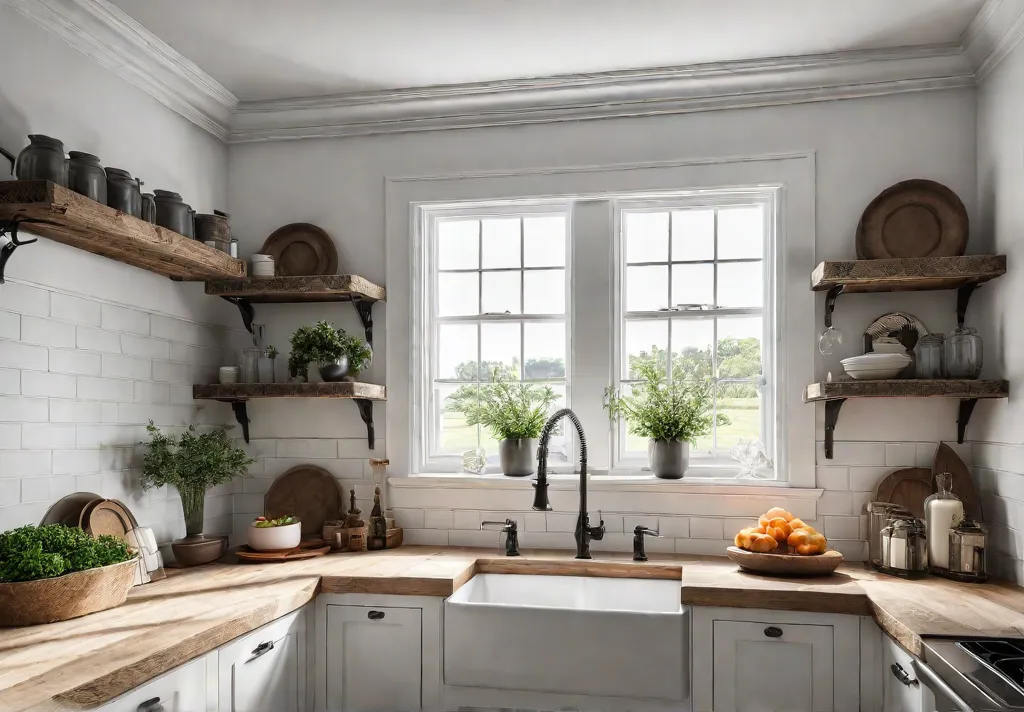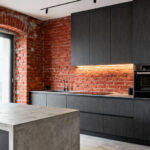As I run my fingers along the weathered beams in my 18th-century home, I can’t help but marvel at the stories they could tell. These remnants of a bygone era have witnessed generations come and go, offering a tangible connection to the past that modern construction cannot replicate. This reverence for heritage and celebration of life’s rich narrative fuels my passion for cultivating rustic charm in the heart of the home – the farmhouse kitchen.
If you, too, find yourself drawn to spaces that feel authentically aged and collected over time, join me on a journey to craft the ultimate farmhouse haven. From embracing the warmth of reclaimed wood to thoughtfully layering vintage treasures, we’ll uncover the essential elements for imbuing your kitchen with soul-soothing character. True rustic style isn’t about recreating a bygone era—it’s about honoring the beauty of imperfections and human touch while forging an environment that nurtures comfort and connection.
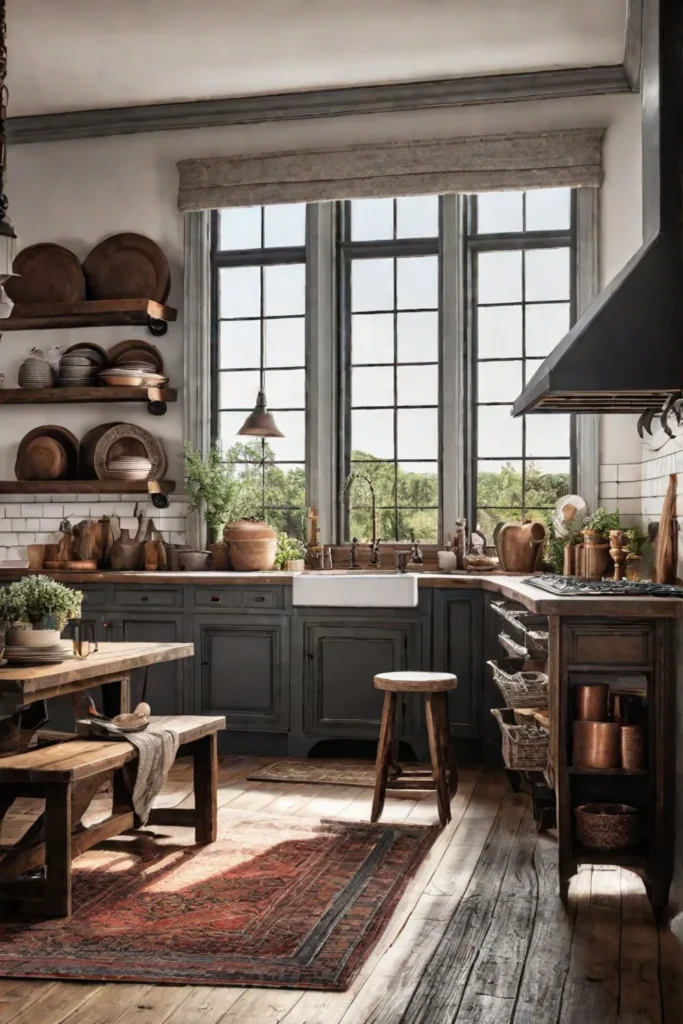
So, let’s begin by exploring how to harness the inimitable allure of salvaged materials, the foundation for any farmhouse kitchen brimming with history and heart.
Embrace the Beauty of Reclaimed Wood
Have you ever run your fingers along the weathered grain of an old timber beam and felt a visceral connection to its storied past? That’s the inexplicable allure of reclaimed wood – its rich patina and tangible history have the power to infuse a space with rustic soul. For the farmhouse kitchen of your dreams, embracing the beauty of salvaged wood is an absolute must.
The Rustic Elegance of Reclaimed Wood
Each plank of reclaimed wood bears the marks of its journey, from the wormholes and nail holes that whisper tales of its structural origins to the glorious silvering and crazing that only decades of exposure can impart. This organic aging process is impossible to replicate – a living embodiment of the past that lends unparalleled warmth and character to a space.
Sustainable Storytelling
Beyond its aesthetic charms, incorporating reclaimed wood into your kitchen design is an eco-friendly choice that aligns with the preservationist spirit. These salvaged materials were destined for the landfill before being lovingly rescued and repurposed. Each plank comes with a sense of honoring tradition while treading lightly on the planet.
Rustic Versatility
The applications for reclaimed wood in the kitchen are limited only by your imagination. Lay down rustic hewn planks for a showstopping floor that will patina further with age. Craft a rugged yet elegant kitchen island from salvaged timbers. Install open shelving with reclaimed barn wood for a pantry that seems to have sprung from the pages of a Currier & Ives print.
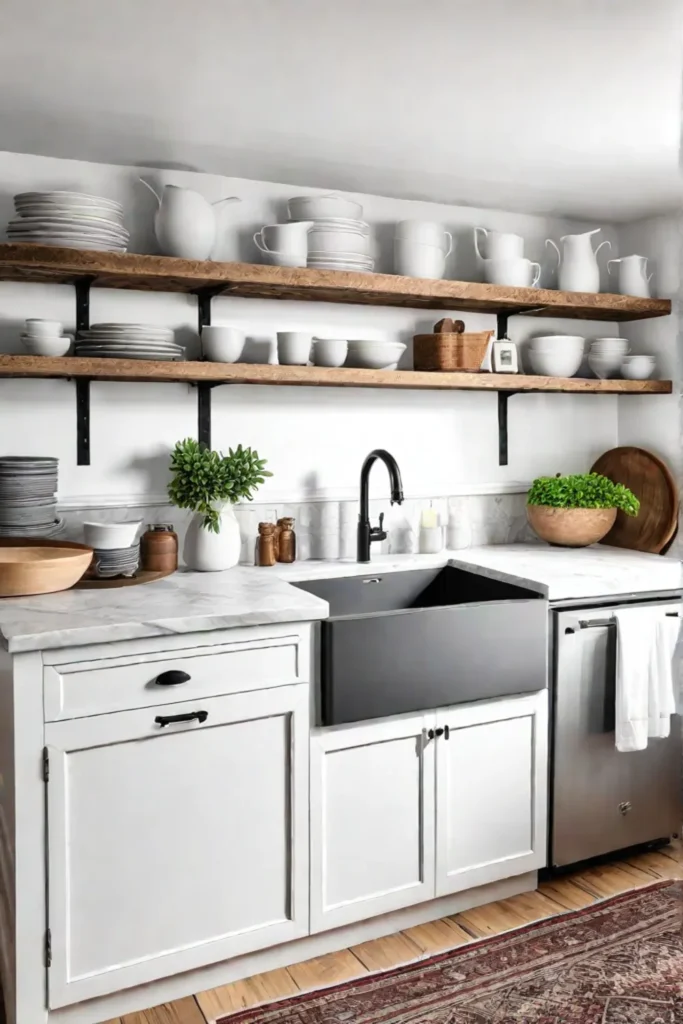
Integrating the beauty of reclaimed wood into your farmhouse kitchen is an act of sustainable storytelling that will imbue your space with a tangible soul. With thoughtful touches of salvaged materials, you’ll honor the past while crafting a richly layered backdrop for future memories. The gentle whispers of history inherent in each plank will forever remind you of the enduring human narrative embodied within your home’s walls.
Seamlessly blending vintage inspiration with a fresh perspective is the true artistry of heritage design, and the next essential element for achieving rustic charm is embracing the nostalgic appeal of vintage furniture.
Vintage Furniture: A Touch of Nostalgia
Have you ever run your fingers along the worn grooves of an antique dresser and imagined all the stories it could tell? In my experience, there’s an undeniable magic to vintage furniture that modern pieces can’t replicate. Each dent, scratch, and faded patina is a delicious mystery begging to be unraveled.
The Thrill of the Hunt
Part of the allure of decorating with vintage finds is the thrill of the hunt itself. Scouring local antique shops, estate sales, and even online vendors becomes an adventure full of surprises. You never know when that perfect farmhouse hutch or Jacobean refectory table will reveal itself amidst a kaleidoscope of collectibles. Developing a keen eye for quality craftsmanship and untapped potential is part of the game.
Distressed Perfection
When cultivating a farmhouse kitchen ambiance, seek out pieces with beautifully distressed finishes and rustic, hand-hewn detailing. Wrought iron hardware, chipped paint, and worn wood grain are all badges of honor that breathe life into these survivors from yesteryear. Don’t be afraid to embrace imperfections – they’re the very characteristics that forge an authentic, collected-over-time aesthetic.
Repurposed Ingenuity
Some of my favorite vintage acquisitions are those I’ve repurposed into unexpected kitchen workhorses. An antique pine sideboard reborn as a hardworking kitchen island? Genius. That stately oak buffet cabinet now serves as a pantry for storing dry goods? Brilliant. Upcycling allows you to marry past and present in wonderfully inventive ways.
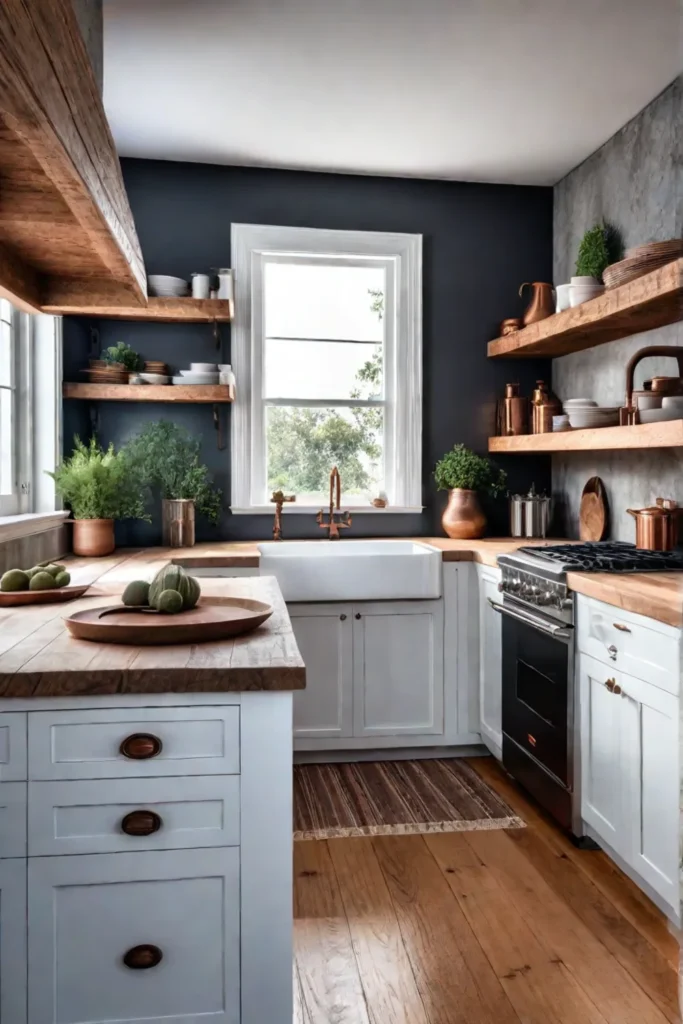
With some elbow grease and creativity, a humble vintage find can become the showstopping centerpiece of your farmhouse kitchen. Remember to balance these timeworn treasures with modern accents for a cohesive, livable flow. After all, heritage design is about far more than mere recreation – it’s a celebration of life’s rich, lingering narrative.
Speaking of natural elements that cultivate an inviting sense of history, let’s delve into the next farmhouse fundamental: the warmth of wood, stone, and other rustic materials.
The Warmth of Natural Materials
What could be more fitting for a farmhouse kitchen than materials plucked straight from the earth? I’ll admit, there’s an irresistible appeal to surfaces that have sprouted organically over decades rather than mass-produced on an assembly line. That tangible sense of history and human touch lends authenticity to the rustic charm aesthetic.
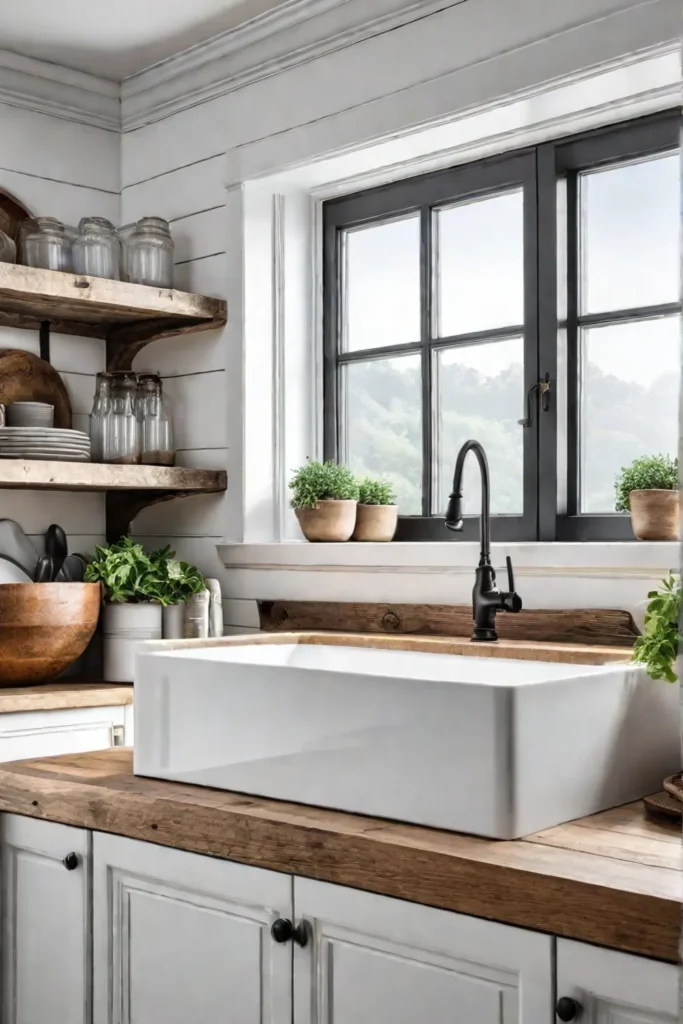
Selecting Natural Materials for Countertops and Flooring
Countertops and floors present ideal opportunities to ground your kitchen in natural materials. I’m quite partial to soapstone—those soft gray tones and velvety texture make a space feel wonderfully lived-in from the moment it’s installed. Of course, you can’t go wrong with good old granite, especially pieces with a rugged, almost raw-edged quality. The unique veining and pitting tell a story all its own.
There’s nothing quite like the rustic allure of a brick floor for flooring. Whether you opt for the real deal or convincing modern reproductions, those color variations and that gently distressed texture underfoot add immeasurable warmth and character. You can even get creative with a brick accent wall or backsplash to enhance visual interest.
Integrating Natural Fibers into Decor
While stone and brick form the sturdy backbone, don’t overlook the softening effect of incorporating natural fibers. A simple linen curtain or cotton area rug beckons you to linger a while in the cozy kitchen environs. I’m particularly fond of nubby textures that capture the essence of a pastoral lifestyle. Just be sure to treat these pieces with the proper care to maximize their longevity amidst cooking splashes and spills.
In many ways, copper epitomizes the spirit of farmhouse design with its rich warmth and beautifully aging patina. I love incorporating vintage copper pots, kettles, or even repurposed plumbing fixtures as decor elements that develop more character over time. That evolving natural finish is something to be cherished, not polished away.
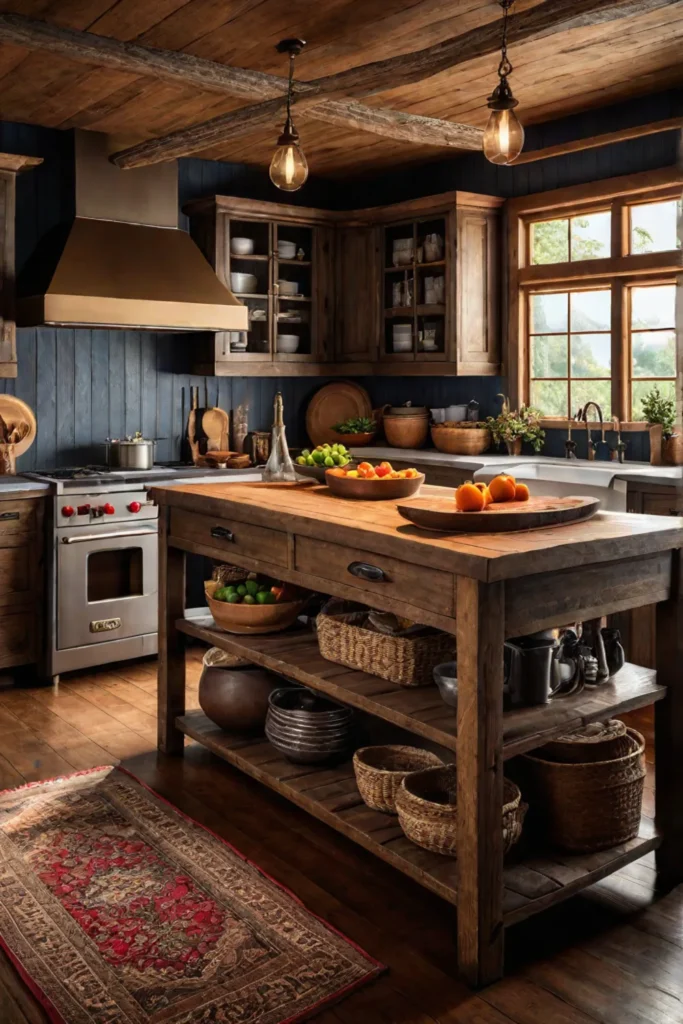
The true genius in cultivating a farmhouse-worthy kitchen lies in striking the right balance between durability and aesthetics. With some thoughtful sourcing of natural materials, you can craft a space that feels as sturdy as the day it was built while exuding the cozy, well-trodden ambiance of another era. Ultimately, it’s about creating an environment that nurtures a sense of belonging and timelessness. Speaking of timeless elements, you can’t overlook the architectural charm of exposed ceiling beams…
Highlighting Exposed Beams: Architectural Charm
As an old soul with a penchant for historic preservation, few design elements stir my heart like exposed wood beams. These sturdy remnants of a home’s original timber framing are an undeniable reminder of its architectural pedigree. With their rustic knots and richly textured grain, exposed beams add unparalleled warmth and character that instantly elevates a space.
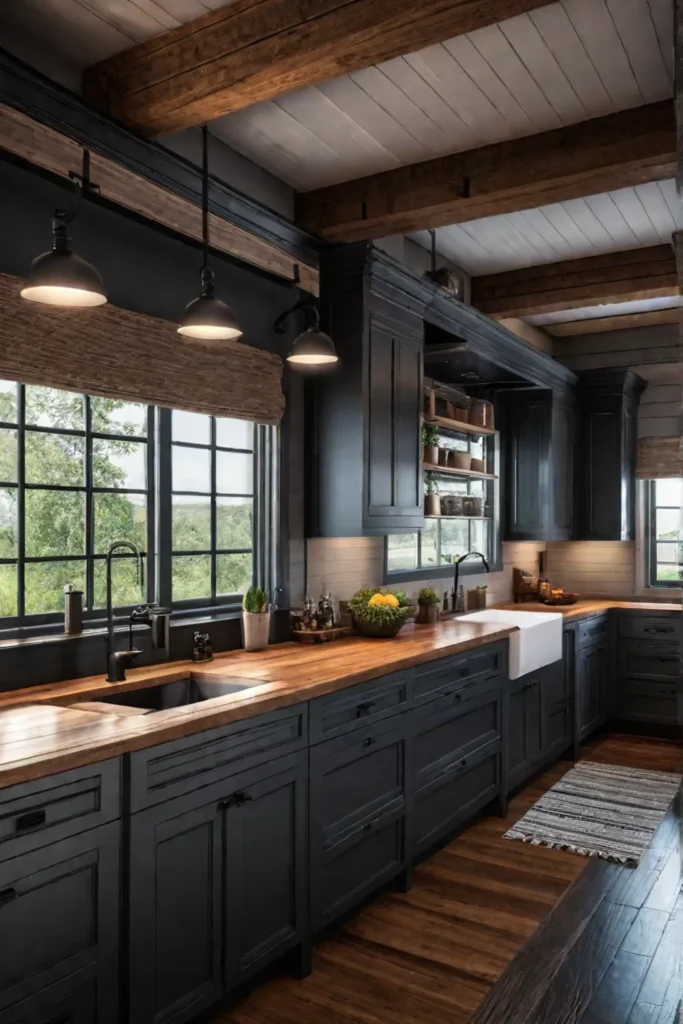
Enhancing the Rustic Look of Exposed Beams
When accentuating the natural beauty of exposed beams, I’m an ardent believer in distressed finishes. By artfully stripping away layers of paint or gently wire brushing the surface, you’ll reveal the wood’s raw, aged allure. Consider a whitewash treatment highlighting the intricate grain patterns for an even more antiqued effect.
Pairing Exposed Beams with Lighting and Decor
Of course, no rustic kitchen design is complete without the perfect illumination. I often suggest suspending vintage-inspired pendant lights from the exposed beams – a simple yet impactful way to meld function and form. Wrought iron fixtures with an aged patina can beautifully complement the beams’ rusticity.
Balancing Architectural Elements
While exposed beams undoubtedly serve as a focal point, don’t let them overwhelm the space. The key is a harmonious balance between these striking ceiling features and the rest of your design elements. Consider incorporating complementary architectural details like decorative corbels or ceiling trim to create a cohesive, well-curated aesthetic.
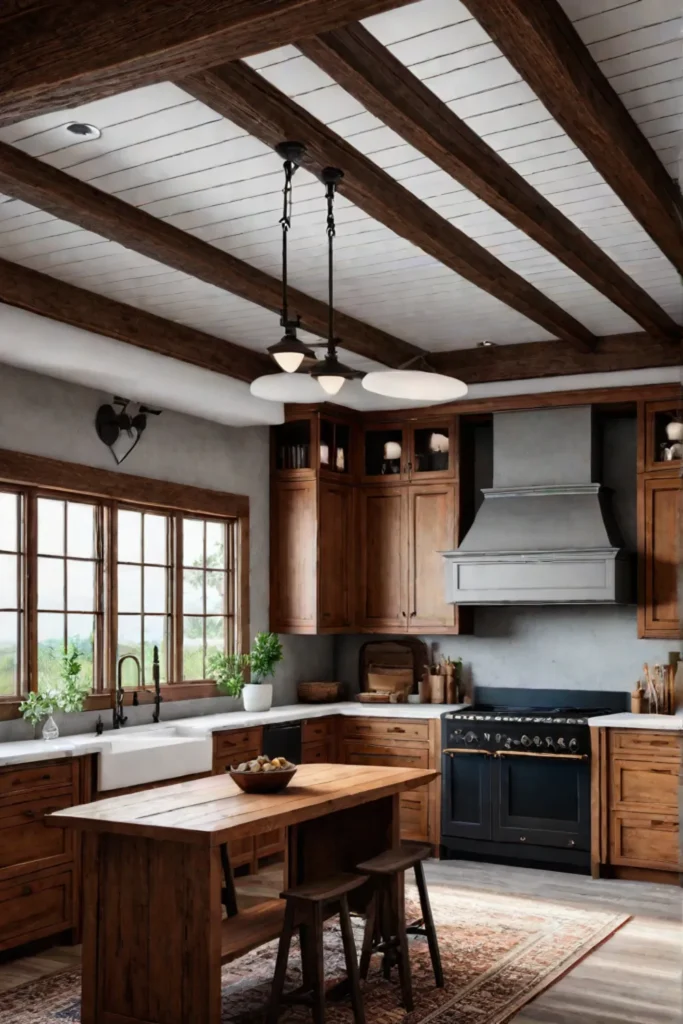
As you thoughtfully layer in these historic touches, remember that true farmhouse style is far more than aesthetics—it celebrates heritage and human narrative. With exposed beams as your muse, craft a kitchen that feels genuinely lived-in and brimming with soul.
Seamlessly blending the old and new, we transition to exploring the perfect rustic color palette to bring this vision to life.
A Palette of Rustic Hues
What shades instantly evoke the cozy allure of a farmhouse kitchen? A thoughtful color story sets the perfect stage for rustic charm, enveloping you in warmth and nostalgia the moment you step inside.
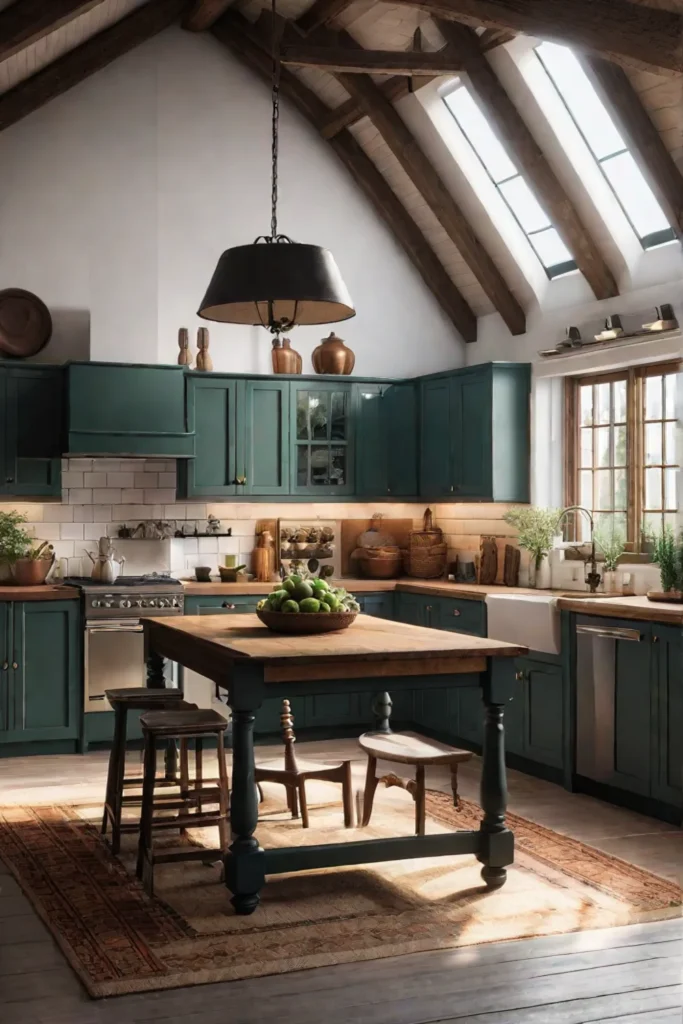
Choosing the Right Paint Colors for a Farmhouse Kitchen
The farmhouse style’s soulful simplicity and connection to the land are its very essence. When it comes to paint, embrace nature’s rich yet understated tones—creamy whites, soft beiges, and organic greens that feel plucked from sun-dappled meadows. Consider Benjamin Moore’s Muslin or Sherwin-Williams’ Kilim Beige for walls that radiate timeless elegance. Explore deeper shades like Behr’s Chocolate Froth or Valspar’s Roycroft Suede for cabinetry to anchor the space.
Adding Pops of Color with Rustic Accents
While the base palette should remain grounded, don’t be afraid to inject lively pops of color that reveal the farmhouse’s spirited, storied past. Scour flea markets and antique shops for vintage enamelware or faded textiles in rustic reds, sunny yellows, and cornflower blues. Weave in these nostalgic accents through ceramics, linens, or even a statement hutch brimming with character. A sprinkling of greenery, whether herbs in terra cotta pots or wildflowers in repurposed bottles, offers an invigorating freshness.
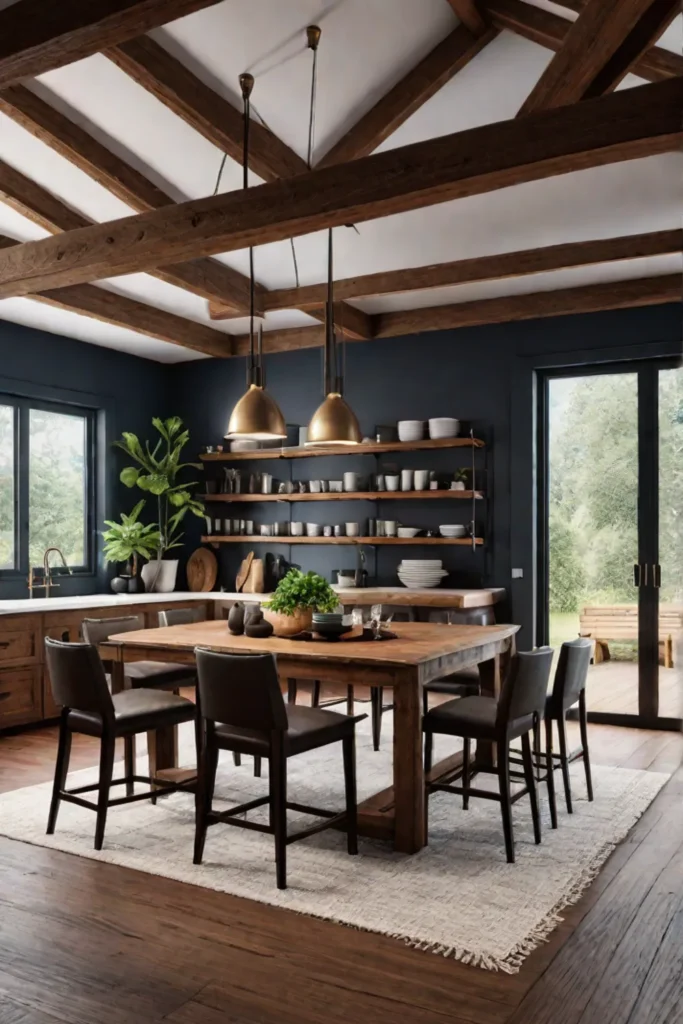
The true artistry lies in thoughtfully layering these elements – like a visual patchwork quilt composed of richly storied hues. With an intuitive touch, a farmhouse kitchen’s color story becomes a living embodiment of comfort, heritage, and heartfelt hospitality.
This carefully cultivated palette provides the ideal foundation as we focus on open shelving – the perfect opportunity to showcase beloved collections while elevating rustic functionality.
Open Shelving: Rustic Display and Functionality
Imagine opening your kitchen cabinets and being instantly transported to a simpler time, surrounded by the warm patina of aged wood and carefully curated collections. This is the transformative power of open shelving, a design element that provides practical storage and allows you to craft a visually captivating narrative. In a farmhouse kitchen, open shelves are the perfect canvas to showcase your rustic charm.
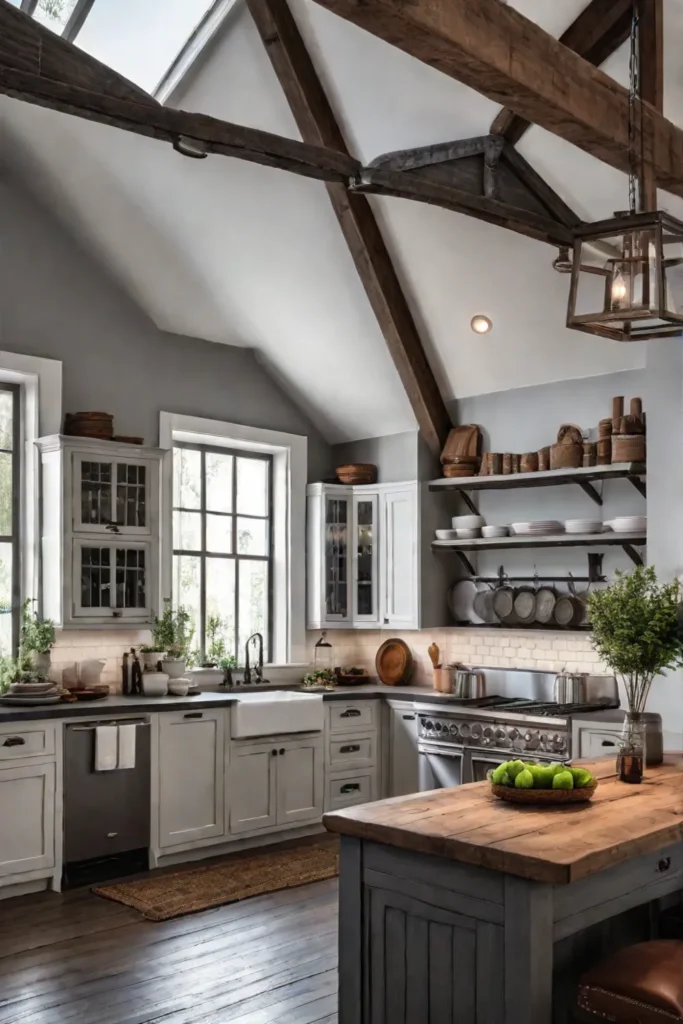
Choosing Materials and Styles for Open Shelving
The key to achieving an authentic farmhouse aesthetic is selecting the right materials. Reclaimed wood, whether sourced from old barns or salvaged from historic buildings, lends an unparalleled sense of character and history. Its knots, grains, and imperfections tell stories of a bygone era, seamlessly blending into your rustic space. Alternatively, wrought iron or galvanized metal shelves offer an industrial edge that complements the farmhouse style beautifully.
Styling Open Shelves for Rustic Charm
Styling open shelves is an art form, and in a farmhouse kitchen, it’s all about striking the perfect balance between practicality and visual appeal. Integrate vintage crocks, enamelware, and woven baskets to store everyday essentials while adding layers of texture and warmth. Intersperse these functional pieces with treasured heirlooms, antique glassware, or even a well-loved cast iron skillet to create vignettes that transport you back in time.
One of the joys of open shelving is the opportunity to showcase your prized possessions. Perhaps it’s a collection of hand-thrown pottery or a set of weathered cutting boards, each item a testament to the artistry of craftsmanship. Carefully arrange these pieces, allowing them to breathe and tell their stories, while creating a cohesive and inviting display.
Illuminate Your Rustic Charm
To truly elevate your open shelving, consider incorporating lighting. Under-shelf lighting serves a practical purpose and creates a warm, inviting ambiance. The gentle glow will highlight the textures and details of your displayed items, transforming your shelves into a focal point that draws the eye and ignites conversation.
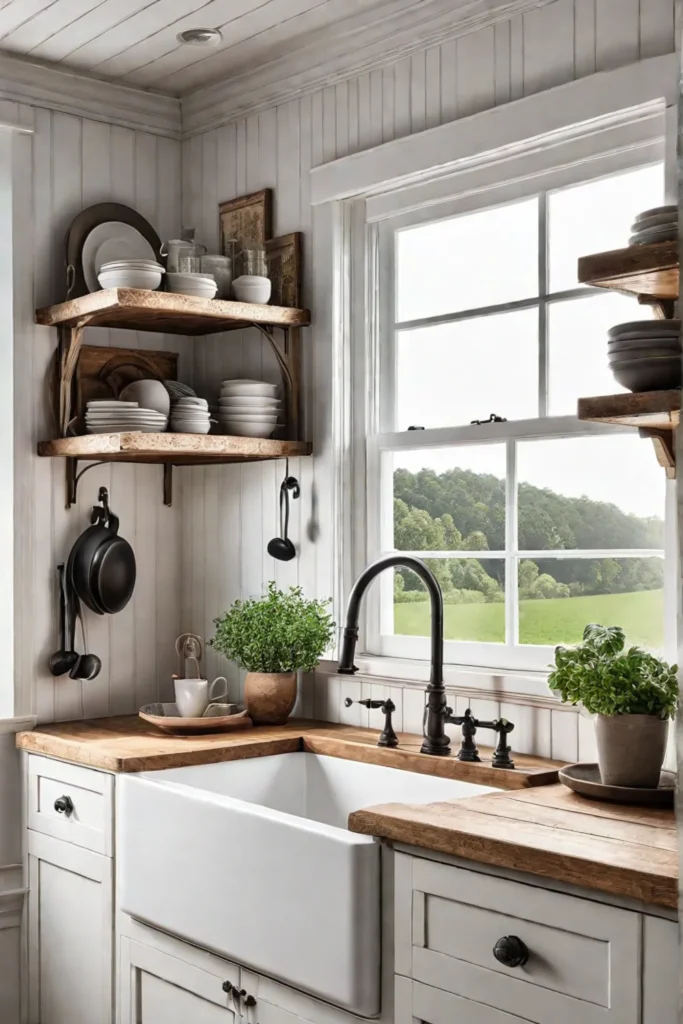
As you step back and admire your handiwork, you’ll realize that open shelving is more than just a storage solution – it’s a canvas for storytelling, a celebration of history, and a reminder that true rustic charm lies in the details that make a space feel authentically lived-in and loved.
Imagine the aroma of freshly baked bread wafting through your kitchen, mingling with the scent of well-seasoned wood and the warm glow of antique glass. This is the essence of a farmhouse kitchen, a space that invites you to slow down, savor the moment, and appreciate the beauty in the ordinary. And what better way to embrace this ethos than with the rustic charm of open shelving?
Farmhouse Sink: A Statement Piece
Have you ever noticed how the sink often becomes the unintentional centerpiece of a farmhouse kitchen? With its deep basin and rustic charm, a classic farmhouse sink commands attention as the hardworking heart of the space. As someone who appreciates design rooted in heritage and human narrative, I find these humble workhorses captivating for their functionality married with time-worn character.
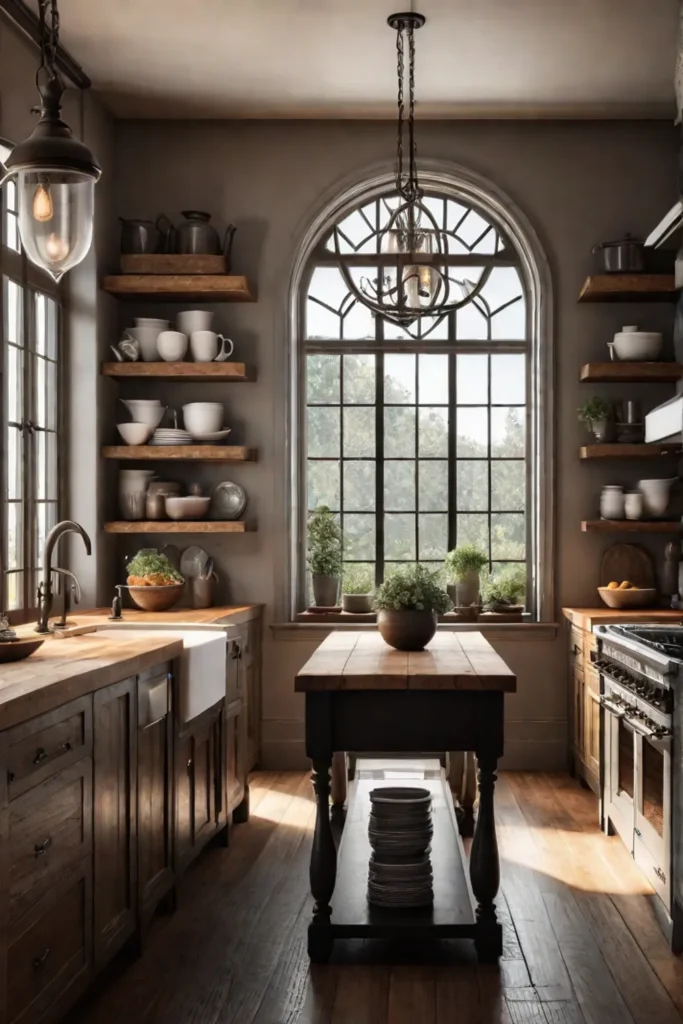
Selecting the Right Farmhouse Sink Material and Size
Not all farmhouse sinks are created equal, my friends. The material you select can significantly influence your kitchen workhorse’s longevity and upkeep demands. Fireclay is my go-to recommendation for that quintessential farmhouse aesthetic—its high-fired clay construction is virtually indestructible and develops a warm, crackled patina over time. Porcelain is another classic option with a glossy, easy-to-clean surface.
If you crave something a little more unique, consider a burnished copper sink—talk about adding some rustic warmth to your kitchen! These beauties will develop a rich, living finish as they age. Remember that copper requires a bit more TLC to maintain its radiant glow.
Size-wise, don’t be afraid to go big and bold. Those cavernous basins were originally designed for heavy-duty farm chores, after all. An extra-deep sink makes kitchen tasks a breeze and reinforces that sense of hardworking utility.
Complementary Faucets and Hardware
Once you’ve settled on your farmhouse sink, it’s time to consider the supporting cast. I’m talking faucets and cabinet hardware that harmonize with the rustic, timeless vibe. My favorite for farmhouse kitchens is a bridge faucet with its high-arcing spout and vintage-inspired design. Or, you could lean into that utilitarian charm with a classic gooseneck faucet—picture its curved neck arching over your deep basin.
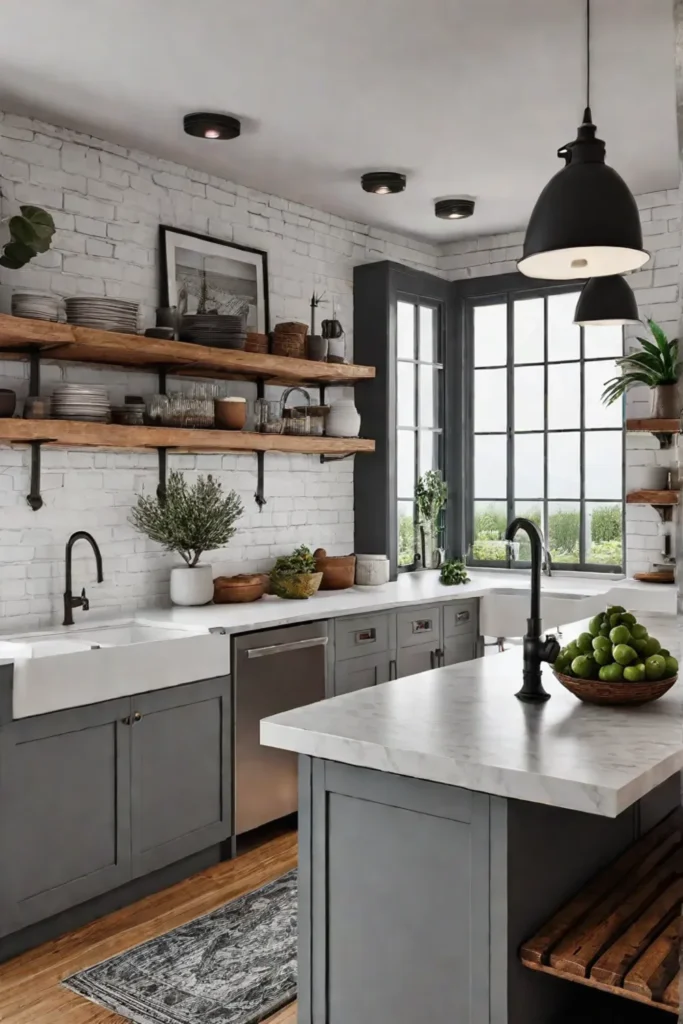
For the cabinet hardware, ditch those sleek modern pulls to favor something with more history and soul. Hand-forged iron or antique brass bin pulls add wonderful warmth and texture. Even repurposing some vintage finds, like ceramic knobs or salvaged industrial pieces, can inject that covetable “collected over time” feel.
No matter which elements you choose, the key is letting your farmhouse sink take center stage as a hardworking beauty anchoring the kitchen aesthetic.
Speaking of setting the tone, let’s move on to another essential piece: rustic lighting that casts your farmhouse kitchen in the perfect warm, atmospheric glow.
Rustic Lighting: Setting the Mood
What better way to imbue a space with warmth and character than through thoughtful illumination? In my ancestral home’s keeping room, the flicker of oil lamps would cast a honeyed glow across the wide plank floors and low-beamed ceilings. Lighting is the thread that ties a farmhouse kitchen’s rustic charm together.
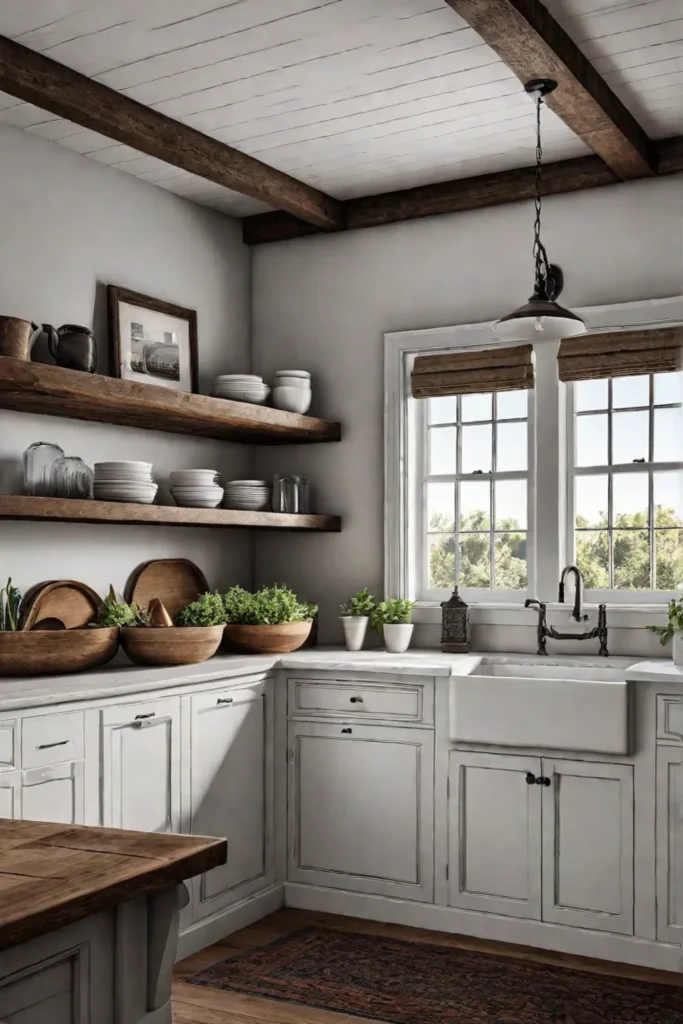
Choosing Rustic Lighting Fixtures
When selecting fixtures, I’m drawn to those with an authentically aged patina – wrought iron chandeliers with curvaceous arms, hand-turned wooden pendants, or tarnished copper lanterns. These pieces ground a space in history, allowing its rustic soul to shine. An heirloom fixture can become the centerpiece, like a grand chandelier presiding over the dining table.
Creating a Layered Lighting Scheme
A well-balanced lighting scheme combines ambient, task, and accent illumination for practicality and ambiance. I enjoy playing with contrasts by juxtaposing vintage-inspired pieces like pendant lights with exposed Edison bulbs alongside sleek modern accents. Strategically hung over workspaces like islands or sinks, these fixtures provide ample brightness for meal prep.
Highlighting Key Areas
I suggest installing decorative wall sconces to enhance function and visual interest further. Their warm glow gently washes over surfaces, illuminating cabinet displays or spotlighting open shelving vignettes. Place them, flanking the kitchen’s focal point – whether a hearty stove alcove or a cozy dining nook.
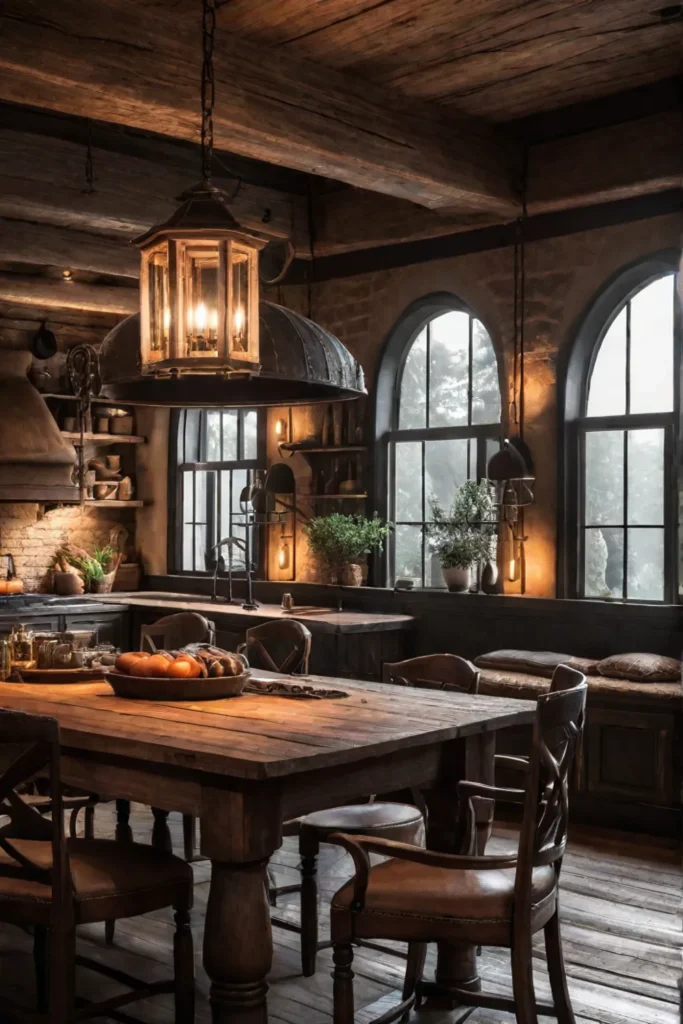
Thoughtfully layered lighting breathes life into a farmhouse kitchen, allowing its rustic soul to take center stage. With the flick of a switch, the space transforms from a bright, lively hub into an inviting, atmospheric hearth.
Once the lighting design sets the perfect mood, it’s time to bring in those final rustic flourishes through careful accessorizing.
Accessorizing with Rustic Charm
What good is a farmhouse kitchen without the perfect accouterments to complete its charming aesthetic? Accessories aren’t merely decorative trinkets – they’re the layered textures and nostalgic touches that breathe soul into a space. Like a well-loved antique quilt or a weathered crock, rustic accessories should feel collected and steeped in history.
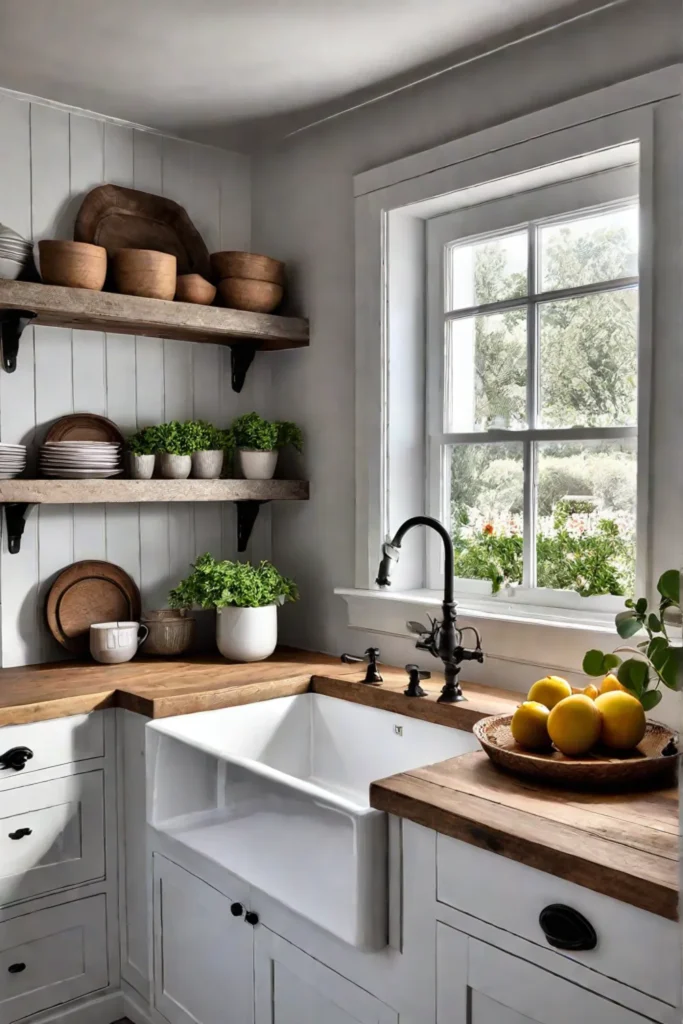
Choosing Rustic Accessories
The key to curating an authentic farmhouse look lies in scouring flea markets and antique shops for vintage treasures with a tangible past. Enamelware pitchers tarnished silver trays, and hand-thrown pottery all make delightful additions with their imperfect beauty. Don’t overlook humble everyday pieces either – antique cookbooks, well-worn utensils, or an heirloom cutting board can add immense character.
Displaying Accessories with Style
With thoughtful arrangement, these rustic accents transcend mere kitsch to become centerpieces of your design story. Dedicate open shelving to a vignette of ironstone crocks and vintage tins. Hang antique grain sacks or patchwork quilts from centuries past on the walls to layer in cozy warmth. Tuck herbs and wildflowers into repurposed vessels for a touch of nature. The possibilities are endless when you let your accessories shape an inviting atmosphere.
No matter how you style them, these humble objects should feel purposefully placed yet effortless – a subtle nod to farmhouse living rather than a contrived showpiece. With an editor’s discerning eye, allow your rustic accessories to conjure visions of a simpler era when handcrafted items were cherished heirlooms passed through generations.
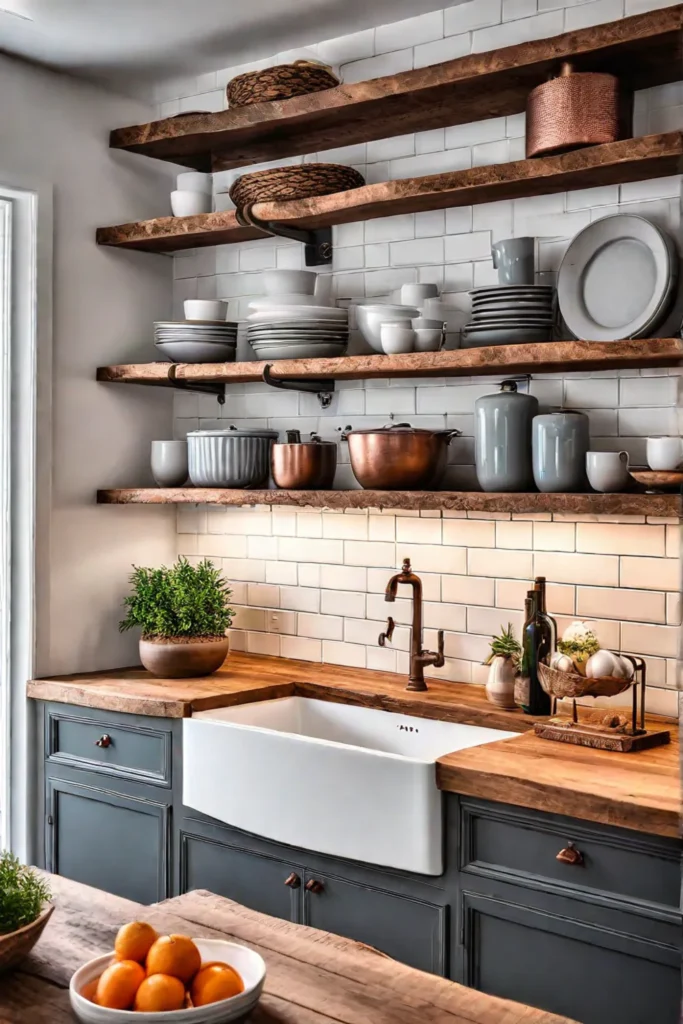
Just like the patina on an antique, true rustic charm cannot be artificially replicated—it must be gently acquired over time through a thoughtful collection of pieces that hold personal meaning and stories to be shared. With your accessories warmly arranged, your farmhouse kitchen transcends mere aesthetics into a richly layered space that welcomes you home.
This thoughtfully curated assemblage of treasures perfectly transitions into our next section on achieving an overarching sense of harmony by purposefully blending rustic elements with modern amenities.
Bringing It All Together: Achieving Harmony
What transforms a mere kitchen into the heart of the home? That elusive, ethereal quality makes you want to linger – the perfect alchemy of soul-soothing textures, aromas wafting from the oven, and sunbeams warming a well-loved space.
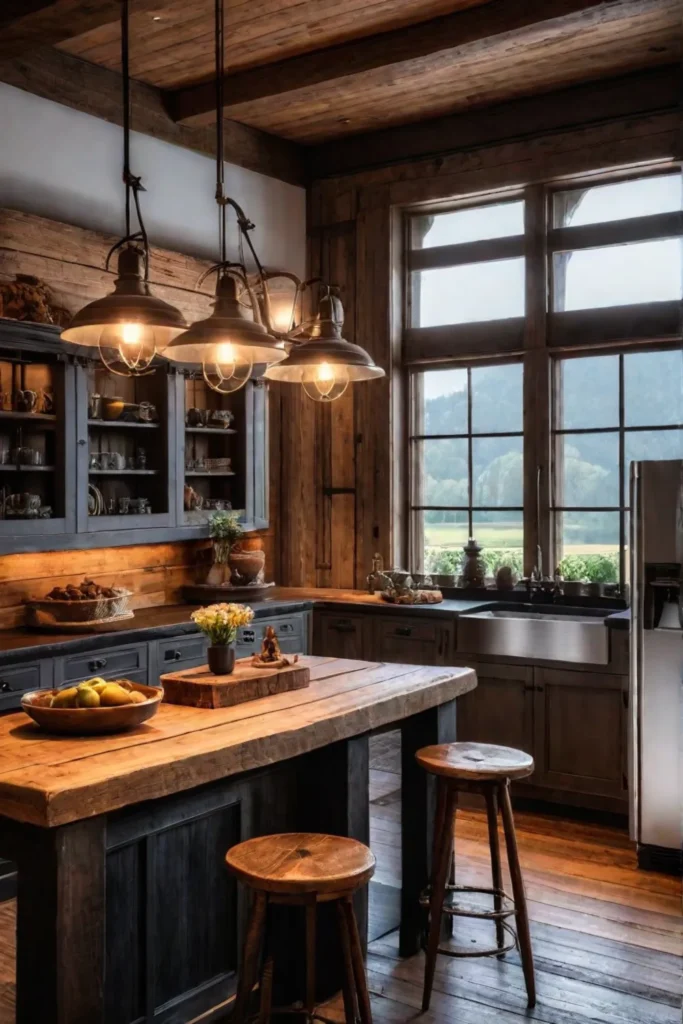
Balancing Rustic and Modern Elements
While rustic elements like weathered wood beams and vintage farmhouse sinks imbue a sense of history, too much of an aged patina can leave the space dark and dreary. Juxtaposing those traditional touches with modern accents prevents the aesthetic from veering into dusty territory. Sleek stainless steel appliances, contemporary lighting, and pops of crisp white instantly brighten and uplift.
Creating a Personalized Farmhouse Kitchen
Of course, the true soul of any kitchen comes from the personal touches that transform it into your own. Pepper the space with beloved family heirlooms – that chipped enamel canister from your grandmother’s pantry, the jadite fire-king bowls you scored at the flea market, or maybe even an antique butcher block bearing the nicks and grooves of generations past. Alongside those treasures, incorporate modern artwork and accessories that speak to your family’s unique story.
Finding the Perfect Balance
Like any great recipe, achieving harmony requires tasting and adjusting until the flavors meld seamlessly. If the rustic elements feel too heavy, introduce some airy open shelving, and if the modern touches seem too stark, layer in nubby textiles and vintage rugs. Trust your senses – when the balance finally clicks, you’ll know it in the way the space envelops you with warmth and familiarity.
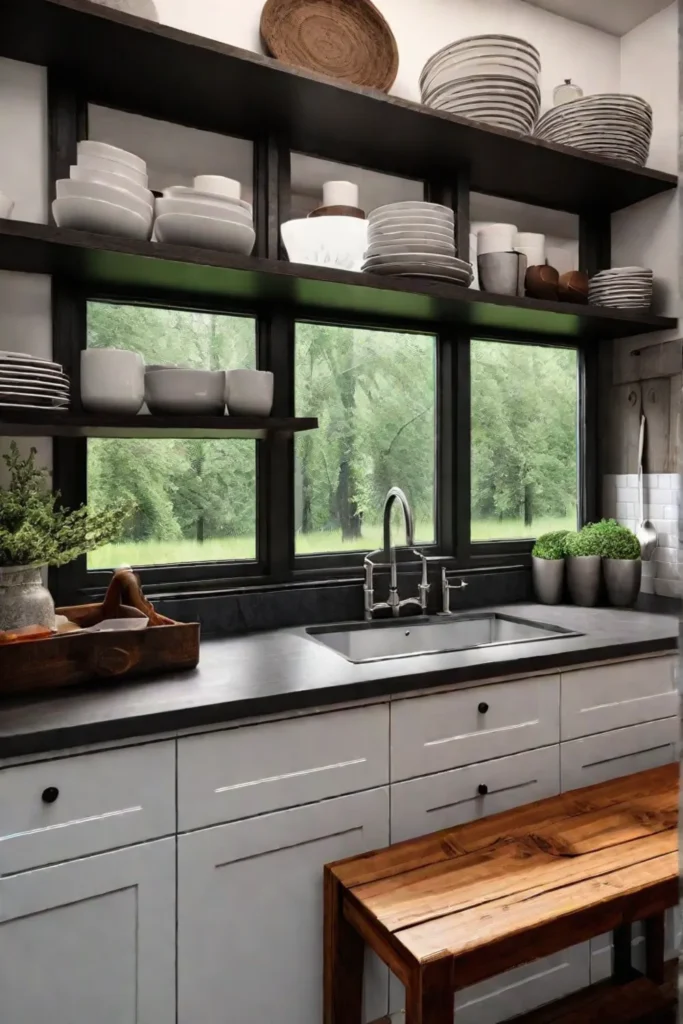
Ultimately, the true magic of a farmhouse kitchen lies in its power to envelop us in a feeling of home. With thoughtful curation and your personal touches, you can craft an atmosphere dripping with nostalgic charm while still suited for modern living. And isn’t that the essence of farmhouse style – a timeless tradition ever-evolving to nourish the way we gather today?
Closing Ideas
As the aroma of freshly baked bread mingles with the rich patina of aged wood, you’ll realize that true rustic charm isn’t about mere aesthetics – crafting an atmosphere that nurtures a sense of belonging. A space that feels authentically lived-in and loved, where every nook and cranny holds whispers of the past while warmly embracing the present.
By thoughtfully curating elements like reclaimed wood, vintage furnishings, and heirloom accents, you’ll create an environment that envelops you in comfort and familiarity. One where the gentle creak of floorboards underfoot and the flickering glow of rustic lighting transport you to a simpler era when homes were crafted with soul and intention.
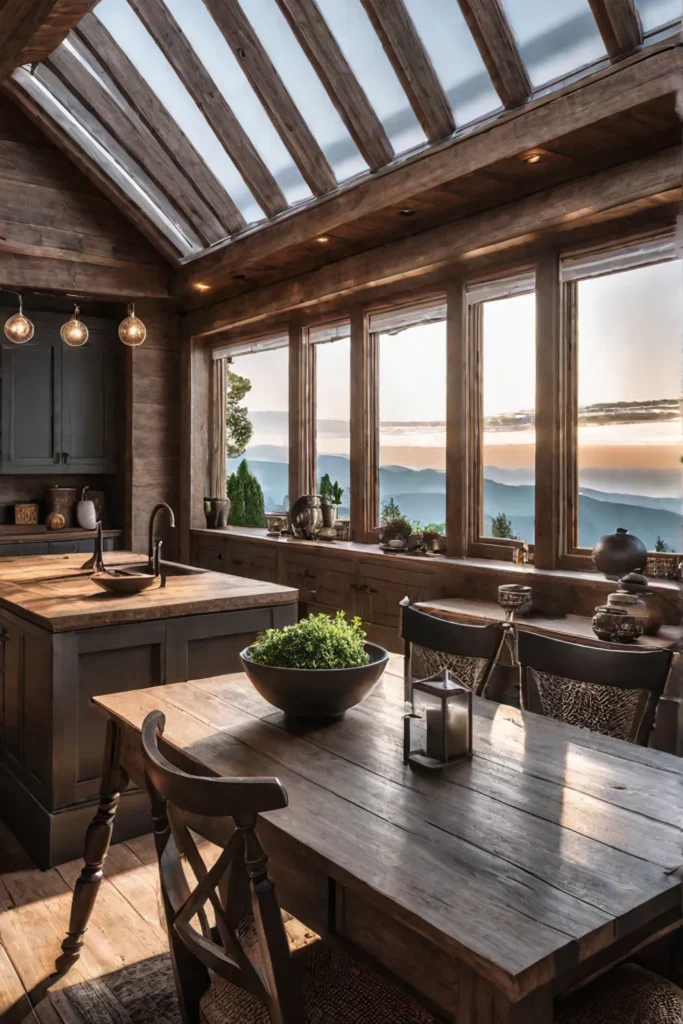
So, I invite you to become a custodian of heritage design – to preserve these tangible links to our shared human narrative while adapting them for modern living. Because, in the end, a farmhouse kitchen isn’t merely a showpiece but a living, breathing hearth that welcomes you home. It’s a space where memories are forged, traditions are upheld, and the beauty of imperfection reigns supreme.
